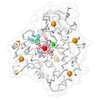[English] 日本語
 Yorodumi
Yorodumi- PDB-8szf: Cryo-EM structure of cinacalcet-bound active-state human calcium-... -
+ Open data
Open data
- Basic information
Basic information
| Entry | Database: PDB / ID: 8szf | ||||||
|---|---|---|---|---|---|---|---|
| Title | Cryo-EM structure of cinacalcet-bound active-state human calcium-sensing receptor CaSR in lipid nanodiscs | ||||||
 Components Components | (Extracellular calcium-sensing ...) x 2 | ||||||
 Keywords Keywords |  SIGNALING PROTEIN / Family C GPCR / Calcium-sensing Receptor (CaSR) / Lipid Nanodiscs / SIGNALING PROTEIN / Family C GPCR / Calcium-sensing Receptor (CaSR) / Lipid Nanodiscs /  Positive Allosteric Modulator / Positive Allosteric Modulator /  Membrane Protein Membrane Protein | ||||||
| Function / homology |  Function and homology information Function and homology informationbile acid secretion / chemosensory behavior / cellular response to peptide / response to fibroblast growth factor / cellular response to vitamin D / phosphatidylinositol phospholipase C activity / Class C/3 (Metabotropic glutamate/pheromone receptors) / calcium ion import / positive regulation of positive chemotaxis / fat pad development ...bile acid secretion / chemosensory behavior / cellular response to peptide / response to fibroblast growth factor / cellular response to vitamin D / phosphatidylinositol phospholipase C activity / Class C/3 (Metabotropic glutamate/pheromone receptors) / calcium ion import / positive regulation of positive chemotaxis / fat pad development /  amino acid binding / cellular response to hepatocyte growth factor stimulus / branching morphogenesis of an epithelial tube / positive regulation of calcium ion import / regulation of calcium ion transport / cellular response to low-density lipoprotein particle stimulus / detection of calcium ion / anatomical structure morphogenesis / axon terminus / positive regulation of vasoconstriction / JNK cascade / chloride transmembrane transport / adenylate cyclase-inhibiting G protein-coupled receptor signaling pathway / amino acid binding / cellular response to hepatocyte growth factor stimulus / branching morphogenesis of an epithelial tube / positive regulation of calcium ion import / regulation of calcium ion transport / cellular response to low-density lipoprotein particle stimulus / detection of calcium ion / anatomical structure morphogenesis / axon terminus / positive regulation of vasoconstriction / JNK cascade / chloride transmembrane transport / adenylate cyclase-inhibiting G protein-coupled receptor signaling pathway /  ossification / G protein-coupled receptor activity / response to ischemia / cellular response to glucose stimulus / intracellular calcium ion homeostasis / positive regulation of insulin secretion / ossification / G protein-coupled receptor activity / response to ischemia / cellular response to glucose stimulus / intracellular calcium ion homeostasis / positive regulation of insulin secretion /  vasodilation / vasodilation /  integrin binding / phospholipase C-activating G protein-coupled receptor signaling pathway / G alpha (i) signalling events / cellular response to hypoxia / G alpha (q) signalling events / basolateral plasma membrane / transmembrane transporter binding / positive regulation of ERK1 and ERK2 cascade / G protein-coupled receptor signaling pathway / apical plasma membrane / neuronal cell body / integrin binding / phospholipase C-activating G protein-coupled receptor signaling pathway / G alpha (i) signalling events / cellular response to hypoxia / G alpha (q) signalling events / basolateral plasma membrane / transmembrane transporter binding / positive regulation of ERK1 and ERK2 cascade / G protein-coupled receptor signaling pathway / apical plasma membrane / neuronal cell body /  calcium ion binding / positive regulation of cell population proliferation / positive regulation of gene expression / calcium ion binding / positive regulation of cell population proliferation / positive regulation of gene expression /  protein kinase binding / protein kinase binding /  cell surface / protein homodimerization activity / identical protein binding / cell surface / protein homodimerization activity / identical protein binding /  plasma membrane plasma membraneSimilarity search - Function | ||||||
| Biological species |   Homo sapiens (human) Homo sapiens (human) | ||||||
| Method |  ELECTRON MICROSCOPY / ELECTRON MICROSCOPY /  single particle reconstruction / single particle reconstruction /  cryo EM / Resolution: 2.8 Å cryo EM / Resolution: 2.8 Å | ||||||
 Authors Authors | He, F. / Wu, C. / Gao, Y. / Skiniotis, G. | ||||||
| Funding support |  United States, 1items United States, 1items
| ||||||
 Citation Citation |  Journal: Nature / Year: 2024 Journal: Nature / Year: 2024Title: Allosteric modulation and G-protein selectivity of the Ca-sensing receptor. Authors: Feng He / Cheng-Guo Wu / Yang Gao / Sabrina N Rahman / Magda Zaoralová / Makaía M Papasergi-Scott / Ting-Jia Gu / Michael J Robertson / Alpay B Seven / Lingjun Li / Jesper M Mathiesen / Georgios Skiniotis /    Abstract: The calcium-sensing receptor (CaSR) is a family C G-protein-coupled receptor (GPCR) that has a central role in regulating systemic calcium homeostasis. Here we use cryo-electron microscopy and ...The calcium-sensing receptor (CaSR) is a family C G-protein-coupled receptor (GPCR) that has a central role in regulating systemic calcium homeostasis. Here we use cryo-electron microscopy and functional assays to investigate the activation of human CaSR embedded in lipid nanodiscs and its coupling to functional G versus G proteins in the presence and absence of the calcimimetic drug cinacalcet. High-resolution structures show that both G and G drive additional conformational changes in the activated CaSR dimer to stabilize a more extensive asymmetric interface of the seven-transmembrane domain (7TM) that involves key protein-lipid interactions. Selective G and G coupling by the receptor is achieved through substantial rearrangements of intracellular loop 2 and the C terminus, which contribute differentially towards the binding of the two G-protein subtypes, resulting in distinct CaSR-G-protein interfaces. The structures also reveal that natural polyamines target multiple sites on CaSR to enhance receptor activation by zipping negatively charged regions between two protomers. Furthermore, we find that the amino acid L-tryptophan, a well-known ligand of CaSR extracellular domains, occupies the 7TM bundle of the G-protein-coupled protomer at the same location as cinacalcet and other allosteric modulators. Together, these results provide a framework for G-protein activation and selectivity by CaSR, as well as its allosteric modulation by endogenous and exogenous ligands. | ||||||
| History |
|
- Structure visualization
Structure visualization
| Structure viewer | Molecule:  Molmil Molmil Jmol/JSmol Jmol/JSmol |
|---|
- Downloads & links
Downloads & links
- Download
Download
| PDBx/mmCIF format |  8szf.cif.gz 8szf.cif.gz | 345.9 KB | Display |  PDBx/mmCIF format PDBx/mmCIF format |
|---|---|---|---|---|
| PDB format |  pdb8szf.ent.gz pdb8szf.ent.gz | 265.2 KB | Display |  PDB format PDB format |
| PDBx/mmJSON format |  8szf.json.gz 8szf.json.gz | Tree view |  PDBx/mmJSON format PDBx/mmJSON format | |
| Others |  Other downloads Other downloads |
-Validation report
| Arichive directory |  https://data.pdbj.org/pub/pdb/validation_reports/sz/8szf https://data.pdbj.org/pub/pdb/validation_reports/sz/8szf ftp://data.pdbj.org/pub/pdb/validation_reports/sz/8szf ftp://data.pdbj.org/pub/pdb/validation_reports/sz/8szf | HTTPS FTP |
|---|
-Related structure data
| Related structure data |  40914MC 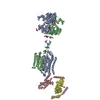 8szgC 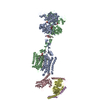 8szhC 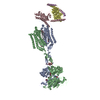 8sziC  41908  41909  41910 M: map data used to model this data C: citing same article ( |
|---|---|
| Similar structure data | Similarity search - Function & homology  F&H Search F&H Search |
- Links
Links
- Assembly
Assembly
| Deposited unit | 
|
|---|---|
| 1 |
|
- Components
Components
-Extracellular calcium-sensing ... , 2 types, 2 molecules AB
| #1: Protein | Mass: 123820.969 Da / Num. of mol.: 1 Source method: isolated from a genetically manipulated source Source: (gene. exp.)   Homo sapiens (human) / Gene: CASR, GPRC2A, PCAR1 / Production host: Homo sapiens (human) / Gene: CASR, GPRC2A, PCAR1 / Production host:   Spodoptera frugiperda (fall armyworm) / References: UniProt: P41180 Spodoptera frugiperda (fall armyworm) / References: UniProt: P41180 |
|---|---|
| #2: Protein | Mass: 108023.055 Da / Num. of mol.: 1 Source method: isolated from a genetically manipulated source Source: (gene. exp.)   Homo sapiens (human) / Gene: CASR, GPRC2A, PCAR1 / Production host: Homo sapiens (human) / Gene: CASR, GPRC2A, PCAR1 / Production host:   Spodoptera frugiperda (fall armyworm) / References: UniProt: P41180 Spodoptera frugiperda (fall armyworm) / References: UniProt: P41180 |
-Sugars , 2 types, 8 molecules 
| #3: Polysaccharide |  / Mass: 424.401 Da / Num. of mol.: 3 / Mass: 424.401 Da / Num. of mol.: 3Source method: isolated from a genetically manipulated source #4: Sugar | ChemComp-NAG /  N-Acetylglucosamine N-Acetylglucosamine |
|---|
-Non-polymers , 5 types, 11 molecules 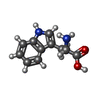



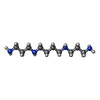




| #5: Chemical |  Tryptophan Tryptophan#6: Chemical | ChemComp-CA / #7: Chemical |  Phosphate Phosphate#8: Chemical |  Cinacalcet Cinacalcet#9: Chemical | ChemComp-SPM / |  Spermine Spermine |
|---|
-Details
| Has ligand of interest | Y |
|---|
-Experimental details
-Experiment
| Experiment | Method:  ELECTRON MICROSCOPY ELECTRON MICROSCOPY |
|---|---|
| EM experiment | Aggregation state: PARTICLE / 3D reconstruction method:  single particle reconstruction single particle reconstruction |
- Sample preparation
Sample preparation
| Component | Name: Cinacalcet-bound active-state human calcium-sensing receptor CaSR dimer in lipid nanodiscs Type: COMPLEX / Entity ID: #1-#2 / Source: RECOMBINANT |
|---|---|
| Source (natural) | Organism:   Homo sapiens (human) Homo sapiens (human) |
| Source (recombinant) | Organism:   Spodoptera frugiperda (fall armyworm) Spodoptera frugiperda (fall armyworm) |
| Buffer solution | pH: 7.5 |
| Specimen | Conc.: 7 mg/ml / Embedding applied: NO / Shadowing applied: NO / Staining applied : NO / Vitrification applied : NO / Vitrification applied : YES : YES |
Vitrification | Cryogen name: ETHANE |
- Electron microscopy imaging
Electron microscopy imaging
| Experimental equipment |  Model: Titan Krios / Image courtesy: FEI Company |
|---|---|
| Microscopy | Model: FEI TITAN KRIOS |
| Electron gun | Electron source : :  FIELD EMISSION GUN / Accelerating voltage: 300 kV / Illumination mode: FLOOD BEAM FIELD EMISSION GUN / Accelerating voltage: 300 kV / Illumination mode: FLOOD BEAM |
| Electron lens | Mode: BRIGHT FIELD Bright-field microscopy / Nominal defocus max: 1500 nm / Nominal defocus min: 500 nm Bright-field microscopy / Nominal defocus max: 1500 nm / Nominal defocus min: 500 nm |
| Image recording | Electron dose: 50 e/Å2 / Film or detector model: GATAN K3 BIOQUANTUM (6k x 4k) |
- Processing
Processing
CTF correction | Type: PHASE FLIPPING AND AMPLITUDE CORRECTION | ||||||||||||||||||||||||
|---|---|---|---|---|---|---|---|---|---|---|---|---|---|---|---|---|---|---|---|---|---|---|---|---|---|
3D reconstruction | Resolution: 2.8 Å / Resolution method: FSC 0.143 CUT-OFF / Num. of particles: 234170 / Symmetry type: POINT | ||||||||||||||||||||||||
| Refinement | Highest resolution: 2.8 Å | ||||||||||||||||||||||||
| Refine LS restraints |
|
 Movie
Movie Controller
Controller





 PDBj
PDBj



